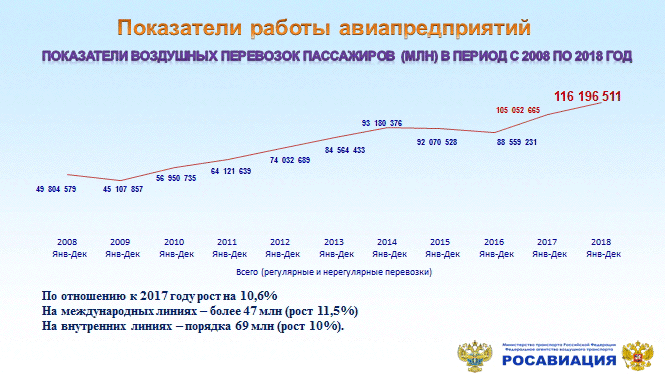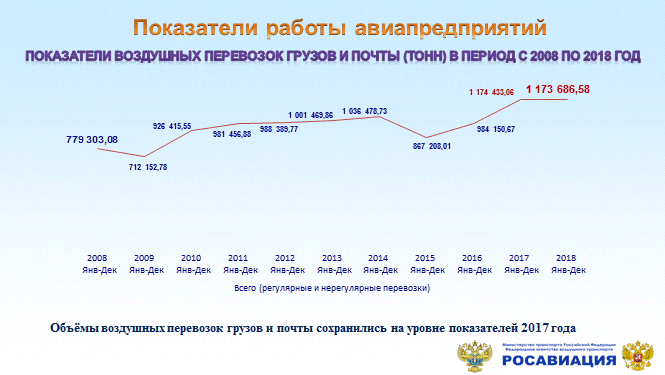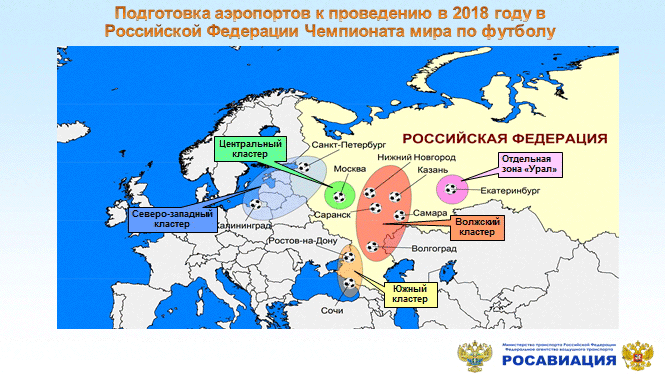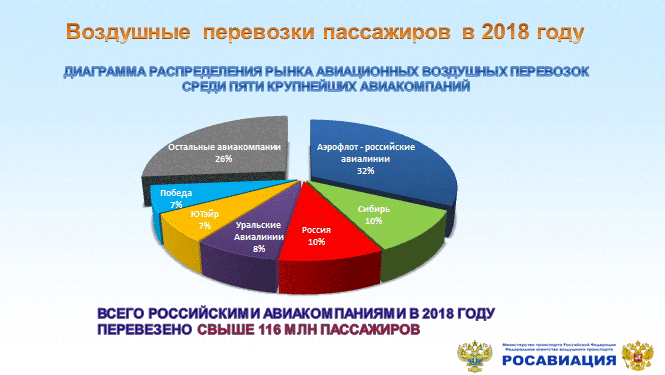
MAIN RESULTS OF THE PRODUCTION ACTIVITY OF ENTERPRISES AND ORGANISATIONS OF CIVIL AVIATION OF RUSSIA IN 2018
In 2018, Russian airlines transported over 116 million passengers (10.6% growth), including over 47 million on international routes (11.5% growth), on domestic routes - about 69 million (10% growth). Passenger traffic (the number of transported passengers) of Russian airlines on domestic airlines (HVL) in the 2000s increases almost annually (except for 2009), having increased from 13.4 million passengers in 2000 to 68.8 million passengers in 2018, the average annual the rate of recovery growth (after the crisis recession of the 1990s) in 2000–2018 was about 9.5%, in 2014–2018, when subsidised subsidised programs contributed to this, the average annual growth rate, despite the impact of the 2014 crisis, 2016, kept at 9.6%, in 2018 - about 10%.

Air transportation of passengers (million) from 2008 to 2018
In the early 2000s, when in the fleet of Russian airlines, a significant proportion was occupied by regional aircraft (aircraft) of a class of 50- and 70-passenger passenger aircraft (including the Tu-134, the standard single-class layout of which (economy) - 76 seats, later without adequate replacement decommissioned), about 41% of regional air passengers carried out their flights, bypassing Moscow. Further, starting from 2003, this indicator was rapidly declining in 2010–2015, after the cardinal re-equipment of the Russian aircraft fleet with modern aircrafts of narrow and wide-body Airbus and Boeing models, was at the level of 24–25%.
In 2016 - 2018, mainly due to the implementation of programs for the subsidisation of regional air transportation, the share of regional passengers flying, bypassing Moscow, increased slightly and reached 26.8% by 2018.
During the period under review, regional air travel, bypassing Moscow, grew from 5.4 million passengers. (2000) to 18.4 million passengers in 2018 (16.48 million passengers only on regular routes), the average annual growth rate was in 2000–2018. about 7.1%, and in 2014-2018 growth rates increased significantly and reached 12%, and in 2018 - 12.2%, which objectively confirms the real impact of the federal and regional programs of subsidising regional air transportation developed during this period.
Leading airlines, which for many years have demonstrated stable and high rates, in 2018 continued the course to strengthen their positions. These are airlines of the Aeroflot Group, Siberia, Ural Airlines, UTair and others. Five industry leaders (Aeroflot, Siberia, Russia, Ural Airlines, UTair) transported 75,153,115,945 passengers in 2018, which represents 64% of the total passenger traffic in the industry.
<…>
Among the airports, Sheremetyevo has the most impressive results, where from the beginning of 2018 about 44.5 million passengers were served (an increase of more than 10%), in Vnukovo - more than 21.3 million (an increase of 2.5%). In 2018, 28 million people were served in Domodedovo (-6%). The decline in Domodedovo Airport is due to the transition of a number of foreign airlines to other UIA airports.

The diagram shows the distribution of market shares among the largest
airlines: Aeroflot - 32%, S7 - 10%, "Russia" - 10%, Ural Airlines - 8%, UTair - 7%, Pobeda - 7%, The rest - 26%
The volume of transported goods and mail in 2018 almost remained at the level of the same period last year and amounted to 1 million 174 thousand tons. The industry leaders in this segment are: VolgaDnepr Group, companies of the Aeroflot Group, Siberia Airlines.
According to the results of the study of indicators from 2014, it can be concluded that the negative indicators of the period 2014-2015 are overcome. Since 2015, a positive trend has been observed in the industry. The volume of transported goods in the period from 2016 to 2017 was characterised by an average growth of 14%.
In 2018, 11 cities of Russia hosted the World Cup (hereinafter referred to as the Championship). In particular, Federal Air Transport Agency took direct part in the preparatory activities for the Championship. With the participation of 6 specialists of Federal Air Transport Agency, a logistics of air transportation of passengers, organised groups of fans, national teams and client groups was developed. With the airlines, issues of increasing the carrying capacities, issuing additional flights for fan transportation between the organising cities of the Championship were worked out, uninterrupted flight service was organised, and Federal Air Transport Agency employees were constantly on duty at the federal passenger traffic control centre.

Key figures of air transportation of cargo and mail (tons) from 2008 to 2018
During the Championship from 14.06.2018 to 15.07.2018 between the city organisers regular and irregular flights of Russian and foreign airlines transported 4,952,135 passengers, and during peak arrival and departure, also including the time of the Championship (from 11.06.2018 to 18.07. 2018), 5 704 544 passengers were transported between the organising cities. In total, 48,458 flights were made between the organising cities of Russian and foreign airlines, of which 42,534 flights were made directly during the Championship.
<…>
Despite the positive dynamics of the industry performance indicators and intensive recovery growth in traffic volume for the first 9 months of 2018 (the statistical reporting form for 2018 as of the material preparation date was not formed), the total loss of airline operations in transport operations amounted to 20.8 billion rubles, in contrast to the profit of 24 billion rubles for the same period of 2017.
The main reason for this situation, according to industry and independent experts (PJSC Sberbank), is the rising cost of aviation fuels and lubricants in the period from the 3rd quarter of 2017 to the IV quarter of 2018. In the period under review (9 months of 2018), airlines' costs for fuel (in terms of transport work) amounted to 287.2 billion rubles (increased by 89.5 billion rubles, taking into account the growth in consumption). The growth of the weighted average cost of jet fuel consumed per unit of transport work (ton-km) when refuelling aircraft of Russian airlines amounted to 33% compared to the same period of 2017 (in the III quarter of 2018, the corresponding growth reached 38%).
As a result, the airline incurred additional expenses in the amount of 71.3 billion rubles just because of rising fuel prices. The share of aviation fuel costs in airline operating expenses increased by 5 percentage points and amounted to 27%, for the same period in 2017 - 23%, and in 2017, the cost of aviation fuels and lubricants occupied not the first, but the second position in the cost structure of Russian airlines. 8 In the conditions of a sharp increase in the cost of aviation fuel, the average freight charge (the cost of transporting one passenger) in 2018 on domestic lines practically did not grow compared to 2017 and amounted to 8,615 rubles. (3.2%), and on international airlines increased just over 10% and amounted to 14,286 rubles, which was primarily due to the high competition in the airline market, as well as the high social sensitivity of this market in the regions of the Far North, the Far East and Siberia.












